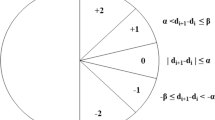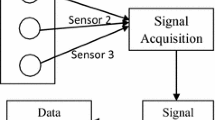Abstract
Multifractal detrended fluctuation analysis (MFDFA) is a powerful tool to uncover nature of complex signals. However, MFDFA runs into difficulties in determining the type of the fitting polynomial trend and making the fitting polynomial trend continuous. To solve these problems, MFDFA based on empirical mode decomposition (MFDFAemd) is developed. Unfortunately, MFDFAemd suffers from negative frequency and difficulties in selecting fractal components. To overcome deficiencies of these traditional methods, this paper proposes a novel version of MFDFA based on optimized empirical mode decomposition (MFDFAoemd). In MFDFAoemd, instantaneous frequency of a signal component is estimated using normalized Hilbert transform and Teager energy operator and a criterion for distinguishing a fractal component from a truly noisy component is established. Moreover, the effectiveness of MFDFAoemd is compared with MFDFA and MFDFAemd by probing a multifractal signal generated by a multifractal cascade model. The comparison displays superiority of MFDFAoemd over MFDFA and MFDFAemd. Next, the performance of MFDFAoemd is further benchmarked against MFDFA and MFDFAemd by analyzing gearbox vibration signals containing different types of single-point fault and those containing different types of compound gear fault. The results show that MFDFAoemd can remedy the shortages of MFDFA and MFDFAemd and has an advantage in diagnosing both single-point gear faults and compound gear faults.
























Similar content being viewed by others
References
Feder, J., Bak, P.: Fractals. Phys. Today 42(9), 90 (1989). https://doi.org/10.1063/1.2811154
Mandelbrot, B.B.: The Fractal Geometry of Nature. W. H. Freeman and Company, New York (1982)
Russell, D.A., Hanson, J.D., Ott, E.: Dimension of strange attractors. Phys. Rev. Lett. 45(14), 1175 (1980). https://doi.org/10.1103/PhysRevLett.45.1175
Pentland, A.P.: Fractal-based description of natural scenes. IEEE T Pattern Anal PAMI 6(6), 661–674 (1984). https://doi.org/10.1109/TPAMI.1984.4767591
Hurst, H.E.: Long-term storage capacity of reservoirs. Trans Amer Soc Civil Eng 116(1), 770–799 (1951)
Peng, C.K., Havlin, S., Stanley, H.E., Goldberger, A.L.: Quantification of scaling exponents and crossover phenomena in nonstationary heartbeat time series. Chaos 5(1), 82–87 (1995). https://doi.org/10.1063/1.166141
Kantelhardt, J.W., Zschiegner, S.A., Koscielny-Bunde, E., Havlin, S., Bunde, A., Stanley, H.E.: Multifractal detrended fluctuation analysis of nonstationary time series. Phys. A 316(1), 87–114 (2002). https://doi.org/10.1016/S0378-4371(02)01383-3
Lin, J., Chen, Q.: Fault diagnosis of rolling bearings based on multifractal detrended fluctuation analysis and Mahalanobis distance criterion. Mech Syst Signal PR 38(2), 515–533 (2013). https://doi.org/10.1016/j.ymssp.2012.12.014
Liu, H., Wang, X., Lu, C.: Rolling bearing fault diagnosis based on LCD–TEO and multifractal detrended fluctuation analysis. Mech Syst Signal PR 60, 273–288 (2015). https://doi.org/10.1016/j.ymssp.2015.02.002
Liu, H., Zhang, J., Cheng, Y., Lu, C.: Fault diagnosis of gearbox using empirical mode decomposition and multi-fractal detrended cross-correlation analysis. J Sound Vib 385, 350–371 (2016). https://doi.org/10.1016/j.jsv.2016.09.005
Ihlen, E.A.: Multifractal analyses of response time series: A comparative study. Behav Res Methods 45(4), 928–945 (2013). https://doi.org/10.3758/s13428-013-0317-2
Du, W., Kang, M., Pecht, M.: Fault diagnosis using adaptive multifractal detrended fluctuation analysis. IEEE T Ind Electron 67(3), 2272–2282 (2019). https://doi.org/10.1109/TIE.2019.2892667
Gu, G.-F., Zhou, W.-X.: Detrending moving average algorithm for multifractals. Phys. Rev. E 82(1), 011136 (2010). https://doi.org/10.1103/PhysRevE.82.011136
Schumann, A.Y., Kantelhardt, J.W.: Multifractal moving average analysis and test of multifractal model with tuned correlations. Phys. A 390(14), 2637–2654 (2011). https://doi.org/10.1016/j.physa.2011.03.002
Huang, N.E., Wu, Z., Long, S.R., Arnold, K.C., Chen, X., Blank, K.: On instantaneous frequency. Adv. Adapt. Data Anal. 1(2), 177–229 (2009). https://doi.org/10.1142/S1793536909000096
Kantelhardt, J.W., Zschiegner, S.A., Koscielny-Bunde, E., Havlin, S., Bunde, A., Stanley, H.E.: Multifractal detrended fluctuation analysis of nonstationary time series. Phys. A 316(1–4), 87–114 (2002). https://doi.org/10.1016/s0378-4371(02)01383-3
Movahed, M.S., Jafari, G.R., Ghasemi, F., Rahvar, S., Tabar, M.R.R.: Multifractal detrended fluctuation analysis of sunspot time series. J. Stat. Mech. Theory E 2006(2), P02003 (2006). https://doi.org/10.1088/1742-5468/2006/02/p02003
Dou, C., Wei, X., Lin, J.: Fault diagnosis of gearboxes using nonlinearity and determinism by generalized Hurst exponents of shuffle and surrogate data. Entropy 20(5), 364 (2018). https://doi.org/10.3390/e20050364
Abry, P., Sellan, F.: The Wavelet-Based Synthesis for Fractional Brownian Motion. In: Sellan, F., Meyer, Y. (eds.) Remarks and fast implementation. Academic Press, Cambridge (1996)
Maragos, P., Kaiser, J.F., Quatieri, T.F.: Energy separation in signal modulations with application to speech analysis. IEEE T. Signal Proces. 41(10), 3024–3051 (1993). https://doi.org/10.1109/78.277799
Tung Tran, V., AlThobiani, F., Ball, A.: An approach to fault diagnosis of reciprocating compressor valves using Teager-Kaiser energy operator and deep belief networks. Expert. Syst. Appl. 41(9), 4113–4122 (2014). https://doi.org/10.1016/j.eswa.2013.12.026
Meneveau, C., Sreenivasan, K.: Simple multifractal cascade model for fully developed turbulence. Phys. Rev. Lett. 59(13), 1424 (1987). https://doi.org/10.1103/PhysRevLett.59.1424
Davis, A., Marshak, A., Cahalan, R., Wiscombe, W.: The Landsat scale break in stratocumulus as a three-dimensional radiative transfer effect: Implications for cloud remote sensing. J. Atmos. Sci. 54(2), 241–260 (1997). https://doi.org/10.1175/1520-0469(1997)054%3c0241:TLSBIS%3e2.0.CO;2
Hosseinabadi, S., Rajabpour, M., Movahed, M.S., Allaei, S.V.: Geometrical exponents of contour loops on synthetic multifractal rough surfaces: Multiplicative hierarchical cascade p model. Phys. Rev. E 85(3), 031113 (2012). https://doi.org/10.1103/PhysRevE.85.031113
Flandrin, P., Rilling, G., Goncalves, P.: Empirical mode decomposition as a filter bank. IEEE Signal Proc. Lett. 11(2), 112–114 (2004). https://doi.org/10.1109/lsp.2003.821662
Wu, Z., Huang, N.E.: A study of the characteristics of white noise using the empirical mode decomposition method. Proc. R Soc. Lond. Ser. A Math. Phys. Eng. Sci. 460(2046), 1597–1611 (2004). https://doi.org/10.1098/rspa.2003.1221
Acknowledgements
The work was supported by Shandong Provincial Natural Science Foundation China (ZR2012EEL07).
Author information
Authors and Affiliations
Corresponding author
Ethics declarations
Conflict of interest
The authors declare that they have no conflict of interest.
Rights and permissions
About this article
Cite this article
Lin, J., Dou, C. & Liu, Y. Multifractal detrended fluctuation analysis based on optimized empirical mode decomposition for complex signal analysis. Nonlinear Dyn 103, 2461–2474 (2021). https://doi.org/10.1007/s11071-021-06223-7
Received:
Accepted:
Published:
Issue Date:
DOI: https://doi.org/10.1007/s11071-021-06223-7




